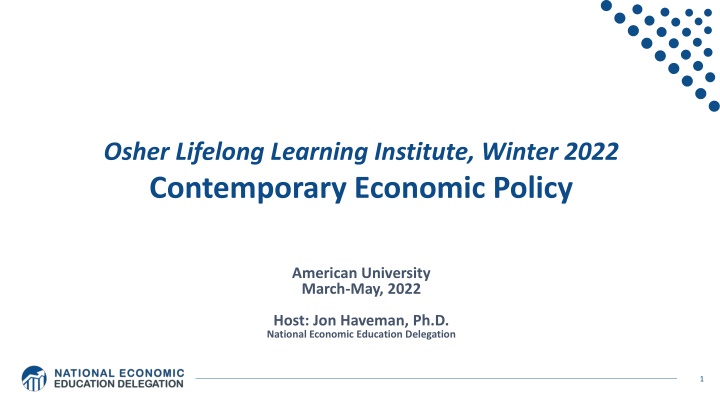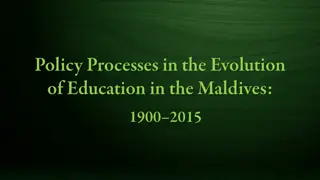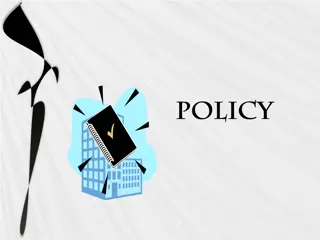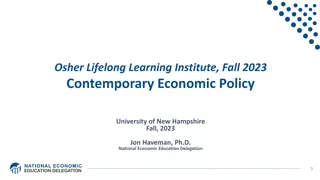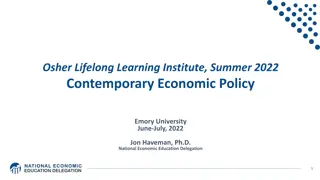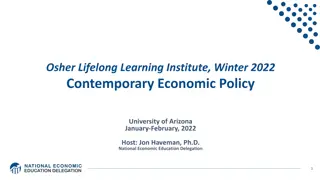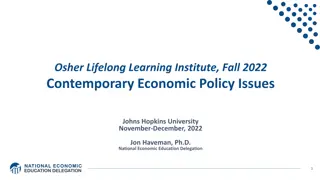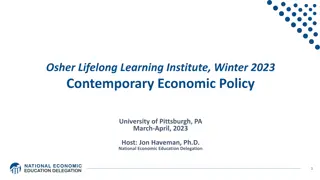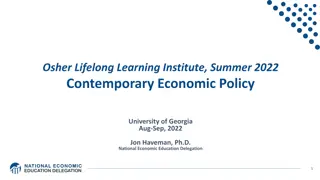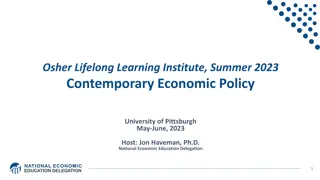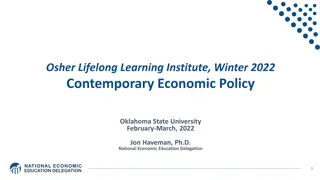Contemporary Economic Policy at Osher Winter 2022
Dive into the world of contemporary economic policy with a focus on topics like US economy, federal debt, trade, healthcare economics, immigration, economic inequality, and more. Explore how the Russia-Ukraine war impacts globalization through disruptions in trade, financial sanctions, and global economic dynamics.
Download Presentation

Please find below an Image/Link to download the presentation.
The content on the website is provided AS IS for your information and personal use only. It may not be sold, licensed, or shared on other websites without obtaining consent from the author.If you encounter any issues during the download, it is possible that the publisher has removed the file from their server.
You are allowed to download the files provided on this website for personal or commercial use, subject to the condition that they are used lawfully. All files are the property of their respective owners.
The content on the website is provided AS IS for your information and personal use only. It may not be sold, licensed, or shared on other websites without obtaining consent from the author.
E N D
Presentation Transcript
Osher Lifelong Learning Institute, Winter 2022 Contemporary Economic Policy American University March-May, 2022 Host: Jon Haveman, Ph.D. National Economic Education Delegation 1
Available NEED Topics Include: Coronavirus Economics Immigration Economics US Economy Housing Policy Climate Change Federal Budgets Economic Inequality Federal Debt Economic Mobility Black-White Wealth Gap Trade and Globalization Autonomous Vehicles Minimum Wages US Social Policy 2
Course Outline Contemporary Economic Policy - Week 1 (3/11): US Economy & Coronavirus Economics - Week 2 (3/18): Federal Debt (Brian Peterson, Central College) - Week 3 (3/25): Trade and Globalization (Alan Deardorff, Univ. of Michigan) - Week 4 (4/1): Healthcare Economics (Veronika Dolar, SUNY-Old Westbury) - Week 5 (4/8): Economics of Immigration (Jennifer Alix-Garcia, Oregon St. Univ.) - Week 6 (4/15): Economic Inequality (Kyle Montanio, Colorado University - Denver) - Week 7 (4/22): Economic Mobility (Kathryn Wilson, Kent State University) - Week 8 (4/29): Discrimination in US Policy History (Jon Haveman, NEED) - Week 9 (5/6): The Black-White Wealth Gap (Mike Shor, Univ. of Connecticut) - Week 10 (5/13): The Gender Wage Gap (Mallika Pung, Univ. of New Mexico) 3
Trade and Globalization Alan Deardorff, Ph.D. University of Michigan 4
Trade and Globalization Alan V. Deardorff University of Michigan Presentation to Osher Lifelong Learning Institute American University March 25, 2022
6 March 10, 2022
Impact of Russia-Ukraine War How Russia-Ukraine war impacts globalization - War itself disrupts trade, especially exports of o Ukraine: wheat o Russia: wheat, oil - Economic sanctions by governments disrupt o Financial linkages o Trade - Private companies stop dealing with Russia 7
Impact of Russia-Ukraine War Financial sanctions by US, EU, UK, and others - Frozen foreign-held assets of individuals, Putin and dozens of others - Restrictions on Russia s Central Bank s use of international reserves - Several Russian banks removed from the Swift international payments system - Cut off many Russian banks from transactions and operations - Long list of Russian companies banned or restricted - Possible restrictions on Russia borrowing from IMF and World Bank 8
Impact of Russia-Ukraine War Trade sanctions by governments - Oil and other energy o Germany puts Nord Stream 2 gas pipeline on hold o US bans from Russia o UK to phase out Russian oil by end of 2022 o EU to become independent from Russia by 2030 - EU bans steel imports from Russia - US restricts exports to Russia, especially technology and military; later also to Belarus; later also luxury goods - EU and UK impose export restrictions similar to US - Ban on Russian air carriers by Canada, EU, US, UK - G-7 to revoke Russia s most favored nation status o Permits them to raise tariffs on Russian goods 9
Impact of Russia-Ukraine War Private Companies Stop Dealing in Russia, per NBC News updated Mar 16: - Automotive: Ford, GM, Toyota, - Aviation: Airbus, Boeing, American, Delta, United, - Energy: BP, ExxonMobil, Shell - Equipment: Caterpillar, Honeywell, Deere - Food & Bev: Burger King, Coke, McDonalds, Starbucks, - Finance: Citigroup, Deutsche Bank, Vanguard, - Consumer goods: Proctor & Gamble, Unilever, Mars, - Leisure: Airbnb, Hilton, Expedia, - Logistics: DHL, FedEx, Maersk, UPS - Media: Netflix, Roku, Disney, - Payment services: Amex, Visa, Western Union, - And many more: Consulting, Retail, Technology 10
Effect of Sanctions Too soon to know fully - Will they stop Russia? o Clearly no, or at least not yet o Sanctions in the past have only sometimes worked - Will they reduce trade? o They already have o But Russia s role in trade is not large in most products o Short-term effects are greater from the war itself 11
Outline What is Globalization? Pros and Cons of Trade Trade Policies The Role of Trade Agreements & WTO (if time) 12
What Globalizations Is Growth over time of many interactions between countries - Trade - Global Value Chains - Foreign Direct Investment - Financial Flows - International Travel - Migration I will focus here on trade 13
Export Volume Worldwide in Billions of US Dollars, 1950-2020 Source: Statista 17
Effects on Economies Supply Chains - Globalization has created long and complex international supply chains
20 NAFTA and the Auto Supply Chain Black, Diamond, and Merrill, One Tiny Widget s Dizzying Journey Shows Just How Critical Nafta Has Become, Bloomberg, February 2, 2017.
21 NAFTA and the Auto Supply Chain Black, Diamond, and Merrill, One Tiny Widget s Dizzying Journey Shows Just How Critical Nafta Has Become, Bloomberg, February 2, 2017.
22 NAFTA and the Auto Supply Chain Black, Diamond, and Merrill, One Tiny Widget s Dizzying Journey Shows Just How Critical Nafta Has Become, Bloomberg, February 2, 2017.
23 NAFTA and the Auto Supply Chain Black, Diamond, and Merrill, One Tiny Widget s Dizzying Journey Shows Just How Critical Nafta Has Become, Bloomberg, February 2, 2017.
24 NAFTA and the Auto Supply Chain Black, Diamond, and Merrill, One Tiny Widget s Dizzying Journey Shows Just How Critical Nafta Has Become, Bloomberg, February 2, 2017.
25 NAFTA and the Auto Supply Chain Black, Diamond, and Merrill, One Tiny Widget s Dizzying Journey Shows Just How Critical Nafta Has Become, Bloomberg, February 2, 2017.
Growth of Global Value Chains, 1970-2015 Source: World Development Report 2020 26
Countries mentioned: China France Italy Japan Malaysia Singapore Spain Vietnam 27 Source: World Development Report 2020
Supply Chains Example: The iPhone assembled in China from parts: Part Come from Accelerometers Germany, the US, South Korea, China, Japan, and Taiwan. Audio chips US, UK, China, South Korea, Taiwan, Japan, and Singapore. Batteries Samsung (South Korea), which has factories in eighty countries. Cameras Qualcomm (US) and Sony (Japan), both with plants in many countries Chips for 3G/4G/LTE networking Qualcomm (US) Compasses AKM Semiconductor (Japan) with plants in the US, France, England, China, South Korea, and Taiwan. Glass screen Corning (US) with plants in twenty-six countries. Gyroscopes Switzerland and many more Source: Krueger 2020, International Trade (What Everyone Needs to Know), p. 254 28
Pros and Cons of Globalization Pros and Cons of Globalization - Gains from Trade oTheory of Comparative Advantage oOther Sources of Gain from Trade - Costs of Trade 30
Gains from Trade Theory of Comparative Advantage
Comparative Advantage The Theory of Comparative Advantage says: - Countries can gain, o By producing More than they need of what they do relatively best, and Less than they need of what they do relatively worst o And exporting the extra to other countries in exchange for what they need - By doing that, ALL countries can o Get more of everything, if that s what they want, and therefore o Gain from trade Illustration with a graph of just 2 countries & 2 goods
Comparative Advantage If US & UK differ in what they can produce US UK Cloth Cloth Production Possibilities Food Food
Comparative Advantage Without trade, their consumption will also differ US UK Cloth Cloth Without trade Consumption = Production CB=PB CA=PA Food Food
Comparative Advantage With free trade, they specialize in what they do best US UK Cloth Cloth PB Free Trade Production CB=PB CA=PA PA Food Food
Comparative Advantage And can consume more by trading. US UK Cloth Cloth PB Trade Free Trade Consumption CB CA CB=PB Trade CA=PA PA Food Food
Comparative Advantage Thus countries both Gain from Trade US UK Cloth Cloth PB Trade Gain from Trade CB CA CB=PB Trade CA=PA PA Food Food
Generality of Comparative Advantage The Theory of Comparative Advantage requires: - Perfect competition (i.e., all buyers and sellers are very small) - Absence of market distortions (externalities, etc.) o i.e., reasons why supplies and demands don t reflect true costs and benefits The Theory of Comparative Advantage does not require: - Any limit on numbers of goods, factors, and countries - That only final goods are traded (thus consistent with supply chains) - That factors (labor, capital) be immobile between countries o (However, the gains from trade then accrue to countries including their mobile-factor owners.)
Generality of Comparative Advantage But note: - Nothing in the theory says that everyone in each country gains - Opening to trade requires o Some industries to shrink or disappear while others expand o Firms and workers in shrinking industries Certainly lose during the transition May be permanently worse off o In example, losers are producers of Cloth in US Food in UK US UK Cloth Cloth PB CB=PB CA=PA PA Food Food
Gains from Trade Other Sources of Gain from Trade
Other sources of Gain from Trade Productivity (most productive firms expand and export) Returns to scale (small countries can support larger firms) Competition (monopolies in small countries lose market power) Variety (buyers, both consumers and firms, can access more choices) Supply chains (firms can source parts from cheapest or best sources) - (That s really just the above, but within industries and firms.) Technology (producers get access foreign technologies)
But there are Costs Economic: - When trade expands (or contracts) o Some firms lose market share or shut down o Other firms supplying inputs to those firms shrink or shut down o Workers in both lose jobs o Their communities lose customers - Macroeconomic cost: Vulnerability to foreign recession/inflation - Dependence on other countries willingness to trade - Vulnerability to trade disruption o Crisis induced (earthquake, flood, disease, war) o Policy induced (sanctions, tariffs, export bans) Non-economic - Loss of cultural differences - Spread of invasive species and plant disease - Spread of human disease
Pause Pause for -Questions -5-Minute Break Next: Trade Policies 44
Trade Policies that Affect Globalization Policies that Encourage It - Tariff Reductions - Trade Agreements - Other Policies that Discourage It - Trump s Tariffs - Trade War 45
Policies that Encourage Globalization
48 Source: Economist
Reduction in tariffs under GATT/WTO MFN. G-7 wants to cancel this for Russia 49 Source: Quartz 2018
